Theoretical Analysis of CAPM Model - University Name, PC-AS0197
VerifiedAdded on 2023/06/05
|14
|2498
|284
Report
AI Summary
This report provides a comprehensive analysis of the Capital Asset Pricing Model (CAPM), examining its application in risk and return assessment for investment decisions. It evaluates systematic and unsystematic risks, discusses problems and critiques of the CAPM model, and explores its assumptions. The report also highlights the model's utility for investors compared to other financial analysis tools, referencing the CAPM equation and its components such as risk-free rate, beta, and market premium. It emphasizes the importance of balancing risk and return, utilizing capital market lines, and considering both realistic and unrealistic assumptions when evaluating investment projects. The conclusion underscores the CAPM model's usefulness in determining investment options and profitability, while referencing alternative models like Arbitrage Pricing Theory. Desklib provides access to this and other solved assignments for students.

CAPM
[Type the document title]
Theoretical model analysis
PC-AS0197
University Name-
[Type the document title]
Theoretical model analysis
PC-AS0197
University Name-
Paraphrase This Document
Need a fresh take? Get an instant paraphrase of this document with our AI Paraphraser
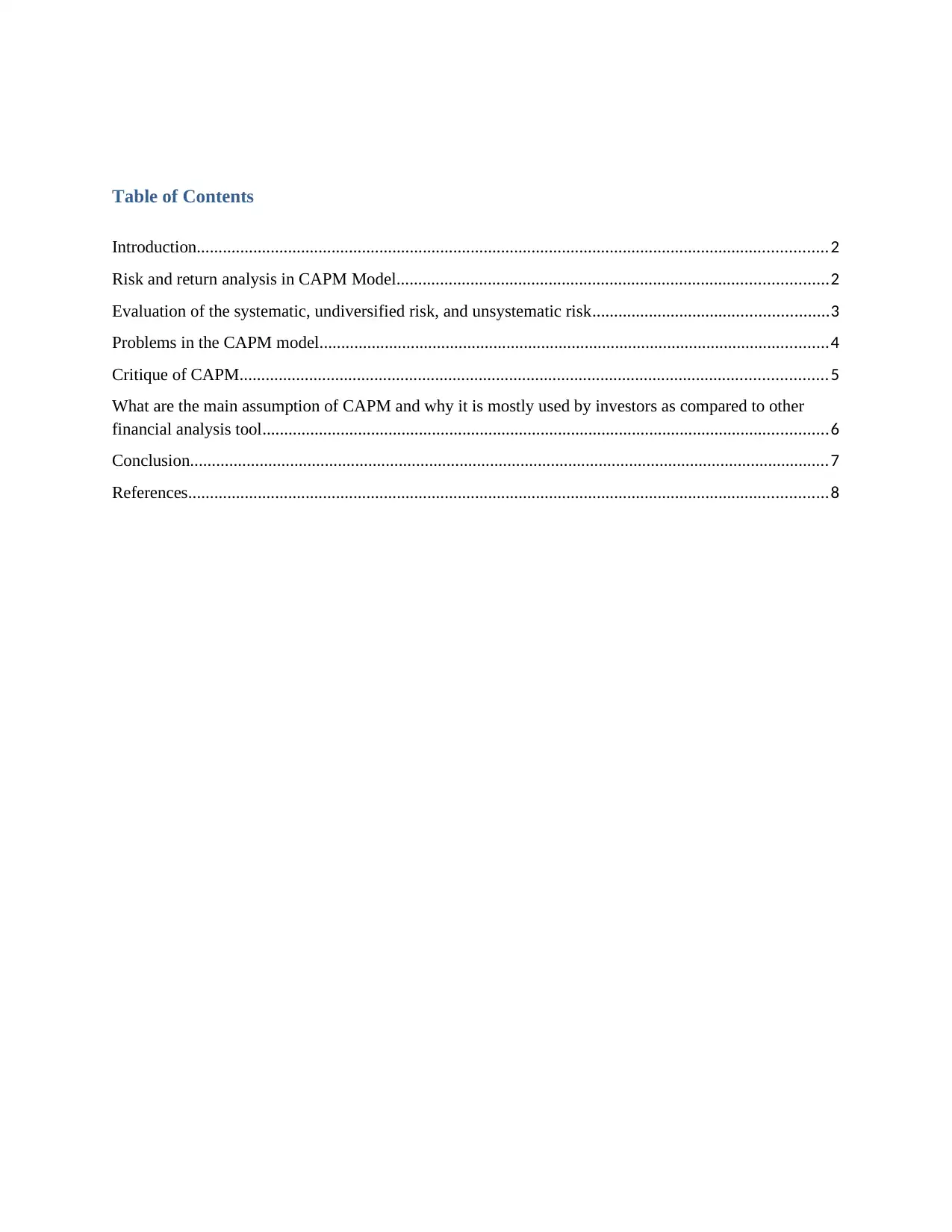
Table of Contents
Introduction.................................................................................................................................................2
Risk and return analysis in CAPM Model...................................................................................................2
Evaluation of the systematic, undiversified risk, and unsystematic risk......................................................3
Problems in the CAPM model.....................................................................................................................4
Critique of CAPM.......................................................................................................................................5
What are the main assumption of CAPM and why it is mostly used by investors as compared to other
financial analysis tool..................................................................................................................................6
Conclusion...................................................................................................................................................7
References...................................................................................................................................................8
Introduction.................................................................................................................................................2
Risk and return analysis in CAPM Model...................................................................................................2
Evaluation of the systematic, undiversified risk, and unsystematic risk......................................................3
Problems in the CAPM model.....................................................................................................................4
Critique of CAPM.......................................................................................................................................5
What are the main assumption of CAPM and why it is mostly used by investors as compared to other
financial analysis tool..................................................................................................................................6
Conclusion...................................................................................................................................................7
References...................................................................................................................................................8
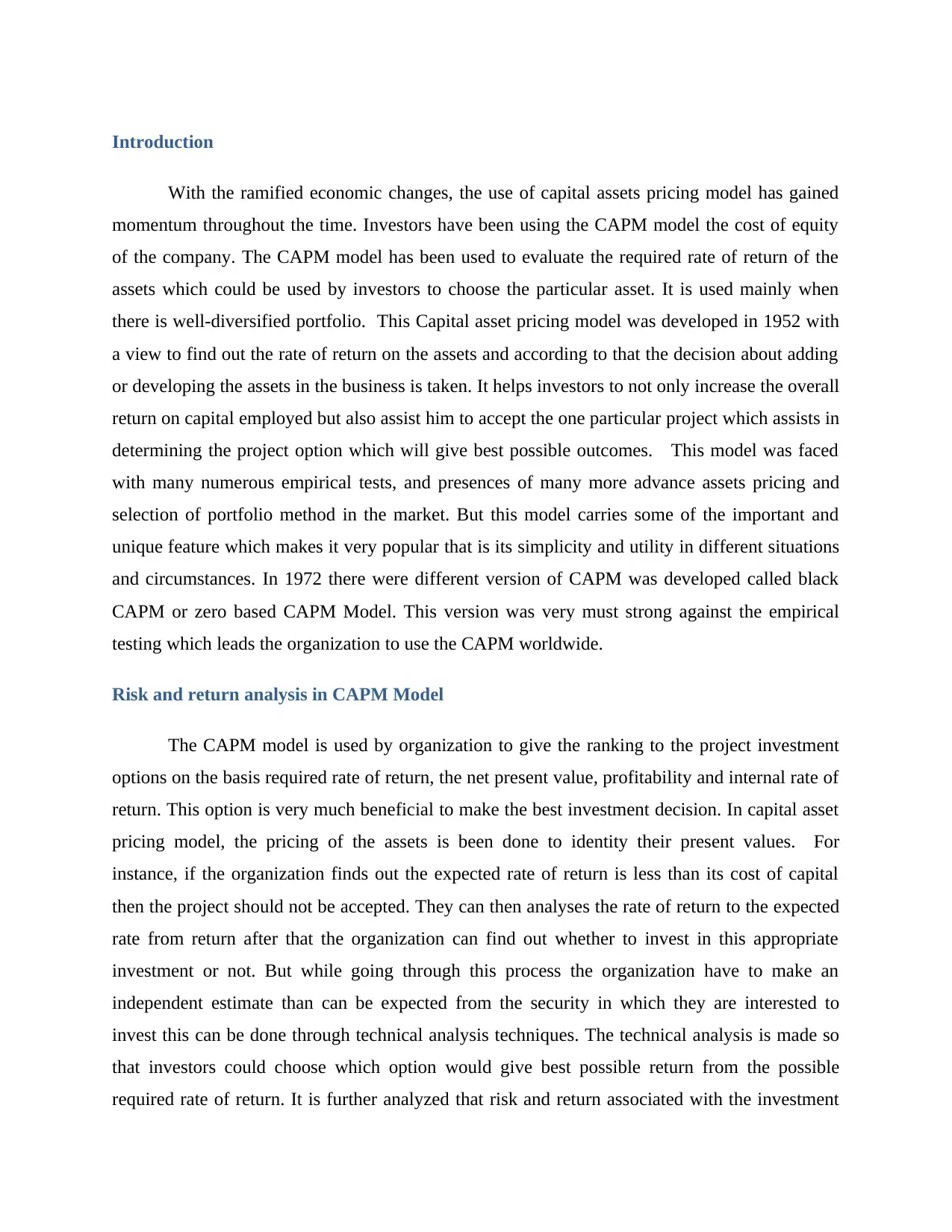
Introduction
With the ramified economic changes, the use of capital assets pricing model has gained
momentum throughout the time. Investors have been using the CAPM model the cost of equity
of the company. The CAPM model has been used to evaluate the required rate of return of the
assets which could be used by investors to choose the particular asset. It is used mainly when
there is well-diversified portfolio. This Capital asset pricing model was developed in 1952 with
a view to find out the rate of return on the assets and according to that the decision about adding
or developing the assets in the business is taken. It helps investors to not only increase the overall
return on capital employed but also assist him to accept the one particular project which assists in
determining the project option which will give best possible outcomes. This model was faced
with many numerous empirical tests, and presences of many more advance assets pricing and
selection of portfolio method in the market. But this model carries some of the important and
unique feature which makes it very popular that is its simplicity and utility in different situations
and circumstances. In 1972 there were different version of CAPM was developed called black
CAPM or zero based CAPM Model. This version was very must strong against the empirical
testing which leads the organization to use the CAPM worldwide.
Risk and return analysis in CAPM Model
The CAPM model is used by organization to give the ranking to the project investment
options on the basis required rate of return, the net present value, profitability and internal rate of
return. This option is very much beneficial to make the best investment decision. In capital asset
pricing model, the pricing of the assets is been done to identity their present values. For
instance, if the organization finds out the expected rate of return is less than its cost of capital
then the project should not be accepted. They can then analyses the rate of return to the expected
rate from return after that the organization can find out whether to invest in this appropriate
investment or not. But while going through this process the organization have to make an
independent estimate than can be expected from the security in which they are interested to
invest this can be done through technical analysis techniques. The technical analysis is made so
that investors could choose which option would give best possible return from the possible
required rate of return. It is further analyzed that risk and return associated with the investment
With the ramified economic changes, the use of capital assets pricing model has gained
momentum throughout the time. Investors have been using the CAPM model the cost of equity
of the company. The CAPM model has been used to evaluate the required rate of return of the
assets which could be used by investors to choose the particular asset. It is used mainly when
there is well-diversified portfolio. This Capital asset pricing model was developed in 1952 with
a view to find out the rate of return on the assets and according to that the decision about adding
or developing the assets in the business is taken. It helps investors to not only increase the overall
return on capital employed but also assist him to accept the one particular project which assists in
determining the project option which will give best possible outcomes. This model was faced
with many numerous empirical tests, and presences of many more advance assets pricing and
selection of portfolio method in the market. But this model carries some of the important and
unique feature which makes it very popular that is its simplicity and utility in different situations
and circumstances. In 1972 there were different version of CAPM was developed called black
CAPM or zero based CAPM Model. This version was very must strong against the empirical
testing which leads the organization to use the CAPM worldwide.
Risk and return analysis in CAPM Model
The CAPM model is used by organization to give the ranking to the project investment
options on the basis required rate of return, the net present value, profitability and internal rate of
return. This option is very much beneficial to make the best investment decision. In capital asset
pricing model, the pricing of the assets is been done to identity their present values. For
instance, if the organization finds out the expected rate of return is less than its cost of capital
then the project should not be accepted. They can then analyses the rate of return to the expected
rate from return after that the organization can find out whether to invest in this appropriate
investment or not. But while going through this process the organization have to make an
independent estimate than can be expected from the security in which they are interested to
invest this can be done through technical analysis techniques. The technical analysis is made so
that investors could choose which option would give best possible return from the possible
required rate of return. It is further analyzed that risk and return associated with the investment
⊘ This is a preview!⊘
Do you want full access?
Subscribe today to unlock all pages.

Trusted by 1+ million students worldwide
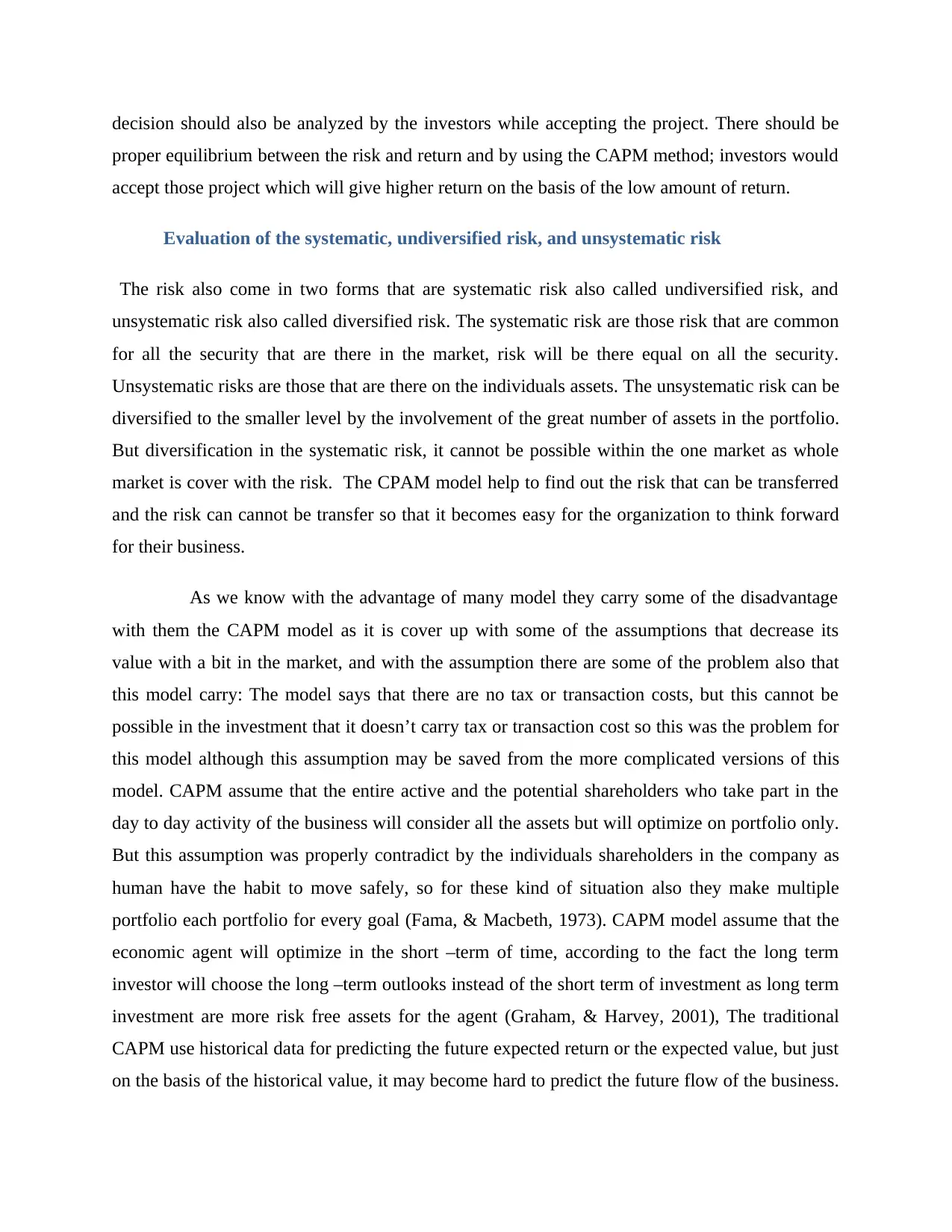
decision should also be analyzed by the investors while accepting the project. There should be
proper equilibrium between the risk and return and by using the CAPM method; investors would
accept those project which will give higher return on the basis of the low amount of return.
Evaluation of the systematic, undiversified risk, and unsystematic risk
The risk also come in two forms that are systematic risk also called undiversified risk, and
unsystematic risk also called diversified risk. The systematic risk are those risk that are common
for all the security that are there in the market, risk will be there equal on all the security.
Unsystematic risks are those that are there on the individuals assets. The unsystematic risk can be
diversified to the smaller level by the involvement of the great number of assets in the portfolio.
But diversification in the systematic risk, it cannot be possible within the one market as whole
market is cover with the risk. The CPAM model help to find out the risk that can be transferred
and the risk can cannot be transfer so that it becomes easy for the organization to think forward
for their business.
As we know with the advantage of many model they carry some of the disadvantage
with them the CAPM model as it is cover up with some of the assumptions that decrease its
value with a bit in the market, and with the assumption there are some of the problem also that
this model carry: The model says that there are no tax or transaction costs, but this cannot be
possible in the investment that it doesn’t carry tax or transaction cost so this was the problem for
this model although this assumption may be saved from the more complicated versions of this
model. CAPM assume that the entire active and the potential shareholders who take part in the
day to day activity of the business will consider all the assets but will optimize on portfolio only.
But this assumption was properly contradict by the individuals shareholders in the company as
human have the habit to move safely, so for these kind of situation also they make multiple
portfolio each portfolio for every goal (Fama, & Macbeth, 1973). CAPM model assume that the
economic agent will optimize in the short –term of time, according to the fact the long term
investor will choose the long –term outlooks instead of the short term of investment as long term
investment are more risk free assets for the agent (Graham, & Harvey, 2001), The traditional
CAPM use historical data for predicting the future expected return or the expected value, but just
on the basis of the historical value, it may become hard to predict the future flow of the business.
proper equilibrium between the risk and return and by using the CAPM method; investors would
accept those project which will give higher return on the basis of the low amount of return.
Evaluation of the systematic, undiversified risk, and unsystematic risk
The risk also come in two forms that are systematic risk also called undiversified risk, and
unsystematic risk also called diversified risk. The systematic risk are those risk that are common
for all the security that are there in the market, risk will be there equal on all the security.
Unsystematic risks are those that are there on the individuals assets. The unsystematic risk can be
diversified to the smaller level by the involvement of the great number of assets in the portfolio.
But diversification in the systematic risk, it cannot be possible within the one market as whole
market is cover with the risk. The CPAM model help to find out the risk that can be transferred
and the risk can cannot be transfer so that it becomes easy for the organization to think forward
for their business.
As we know with the advantage of many model they carry some of the disadvantage
with them the CAPM model as it is cover up with some of the assumptions that decrease its
value with a bit in the market, and with the assumption there are some of the problem also that
this model carry: The model says that there are no tax or transaction costs, but this cannot be
possible in the investment that it doesn’t carry tax or transaction cost so this was the problem for
this model although this assumption may be saved from the more complicated versions of this
model. CAPM assume that the entire active and the potential shareholders who take part in the
day to day activity of the business will consider all the assets but will optimize on portfolio only.
But this assumption was properly contradict by the individuals shareholders in the company as
human have the habit to move safely, so for these kind of situation also they make multiple
portfolio each portfolio for every goal (Fama, & Macbeth, 1973). CAPM model assume that the
economic agent will optimize in the short –term of time, according to the fact the long term
investor will choose the long –term outlooks instead of the short term of investment as long term
investment are more risk free assets for the agent (Graham, & Harvey, 2001), The traditional
CAPM use historical data for predicting the future expected return or the expected value, but just
on the basis of the historical value, it may become hard to predict the future flow of the business.
Paraphrase This Document
Need a fresh take? Get an instant paraphrase of this document with our AI Paraphraser
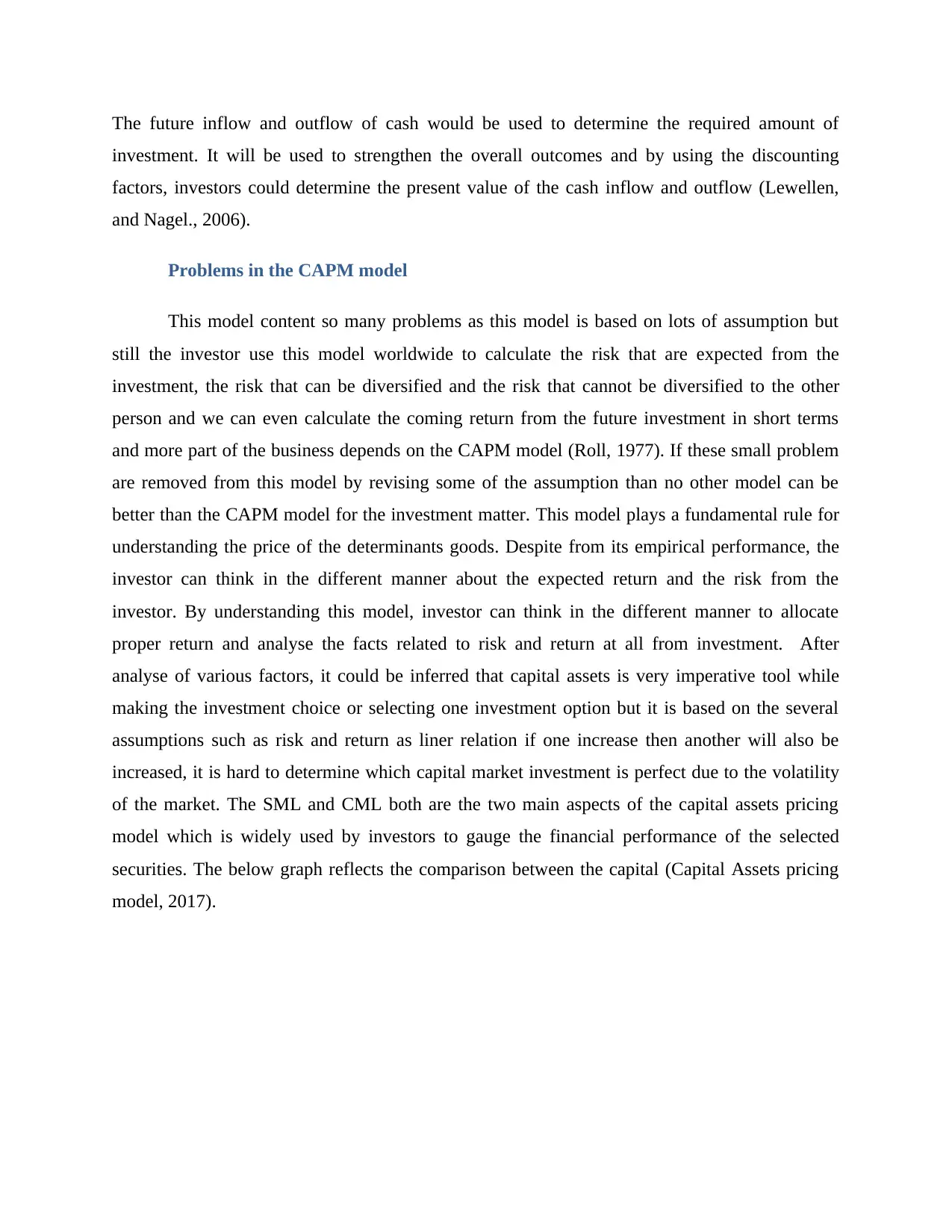
The future inflow and outflow of cash would be used to determine the required amount of
investment. It will be used to strengthen the overall outcomes and by using the discounting
factors, investors could determine the present value of the cash inflow and outflow (Lewellen,
and Nagel., 2006).
Problems in the CAPM model
This model content so many problems as this model is based on lots of assumption but
still the investor use this model worldwide to calculate the risk that are expected from the
investment, the risk that can be diversified and the risk that cannot be diversified to the other
person and we can even calculate the coming return from the future investment in short terms
and more part of the business depends on the CAPM model (Roll, 1977). If these small problem
are removed from this model by revising some of the assumption than no other model can be
better than the CAPM model for the investment matter. This model plays a fundamental rule for
understanding the price of the determinants goods. Despite from its empirical performance, the
investor can think in the different manner about the expected return and the risk from the
investor. By understanding this model, investor can think in the different manner to allocate
proper return and analyse the facts related to risk and return at all from investment. After
analyse of various factors, it could be inferred that capital assets is very imperative tool while
making the investment choice or selecting one investment option but it is based on the several
assumptions such as risk and return as liner relation if one increase then another will also be
increased, it is hard to determine which capital market investment is perfect due to the volatility
of the market. The SML and CML both are the two main aspects of the capital assets pricing
model which is widely used by investors to gauge the financial performance of the selected
securities. The below graph reflects the comparison between the capital (Capital Assets pricing
model, 2017).
investment. It will be used to strengthen the overall outcomes and by using the discounting
factors, investors could determine the present value of the cash inflow and outflow (Lewellen,
and Nagel., 2006).
Problems in the CAPM model
This model content so many problems as this model is based on lots of assumption but
still the investor use this model worldwide to calculate the risk that are expected from the
investment, the risk that can be diversified and the risk that cannot be diversified to the other
person and we can even calculate the coming return from the future investment in short terms
and more part of the business depends on the CAPM model (Roll, 1977). If these small problem
are removed from this model by revising some of the assumption than no other model can be
better than the CAPM model for the investment matter. This model plays a fundamental rule for
understanding the price of the determinants goods. Despite from its empirical performance, the
investor can think in the different manner about the expected return and the risk from the
investor. By understanding this model, investor can think in the different manner to allocate
proper return and analyse the facts related to risk and return at all from investment. After
analyse of various factors, it could be inferred that capital assets is very imperative tool while
making the investment choice or selecting one investment option but it is based on the several
assumptions such as risk and return as liner relation if one increase then another will also be
increased, it is hard to determine which capital market investment is perfect due to the volatility
of the market. The SML and CML both are the two main aspects of the capital assets pricing
model which is widely used by investors to gauge the financial performance of the selected
securities. The below graph reflects the comparison between the capital (Capital Assets pricing
model, 2017).
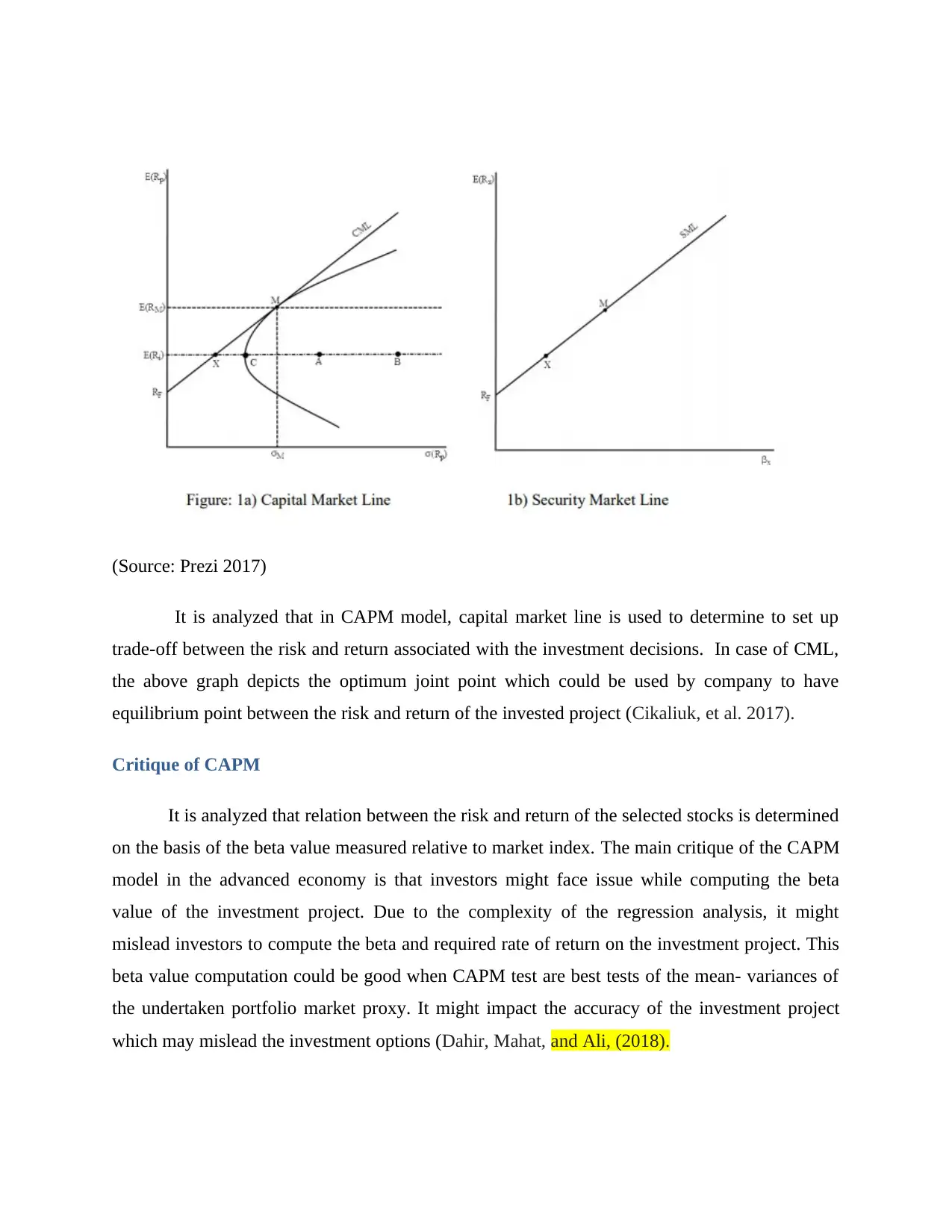
(Source: Prezi 2017)
It is analyzed that in CAPM model, capital market line is used to determine to set up
trade-off between the risk and return associated with the investment decisions. In case of CML,
the above graph depicts the optimum joint point which could be used by company to have
equilibrium point between the risk and return of the invested project (Cikaliuk, et al. 2017).
Critique of CAPM
It is analyzed that relation between the risk and return of the selected stocks is determined
on the basis of the beta value measured relative to market index. The main critique of the CAPM
model in the advanced economy is that investors might face issue while computing the beta
value of the investment project. Due to the complexity of the regression analysis, it might
mislead investors to compute the beta and required rate of return on the investment project. This
beta value computation could be good when CAPM test are best tests of the mean- variances of
the undertaken portfolio market proxy. It might impact the accuracy of the investment project
which may mislead the investment options (Dahir, Mahat, and Ali, (2018).
It is analyzed that in CAPM model, capital market line is used to determine to set up
trade-off between the risk and return associated with the investment decisions. In case of CML,
the above graph depicts the optimum joint point which could be used by company to have
equilibrium point between the risk and return of the invested project (Cikaliuk, et al. 2017).
Critique of CAPM
It is analyzed that relation between the risk and return of the selected stocks is determined
on the basis of the beta value measured relative to market index. The main critique of the CAPM
model in the advanced economy is that investors might face issue while computing the beta
value of the investment project. Due to the complexity of the regression analysis, it might
mislead investors to compute the beta and required rate of return on the investment project. This
beta value computation could be good when CAPM test are best tests of the mean- variances of
the undertaken portfolio market proxy. It might impact the accuracy of the investment project
which may mislead the investment options (Dahir, Mahat, and Ali, (2018).
⊘ This is a preview!⊘
Do you want full access?
Subscribe today to unlock all pages.

Trusted by 1+ million students worldwide
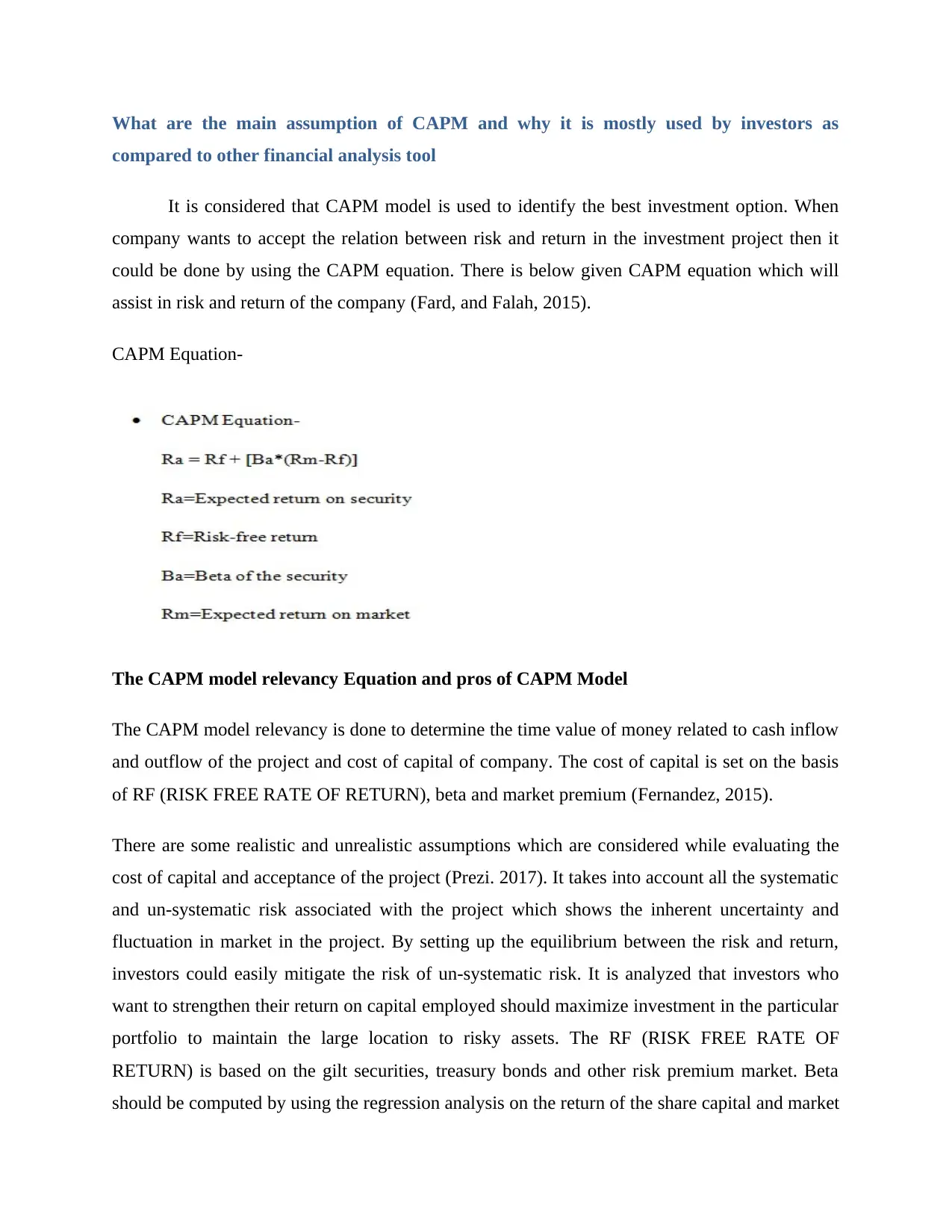
What are the main assumption of CAPM and why it is mostly used by investors as
compared to other financial analysis tool
It is considered that CAPM model is used to identify the best investment option. When
company wants to accept the relation between risk and return in the investment project then it
could be done by using the CAPM equation. There is below given CAPM equation which will
assist in risk and return of the company (Fard, and Falah, 2015).
CAPM Equation-
The CAPM model relevancy Equation and pros of CAPM Model
The CAPM model relevancy is done to determine the time value of money related to cash inflow
and outflow of the project and cost of capital of company. The cost of capital is set on the basis
of RF (RISK FREE RATE OF RETURN), beta and market premium (Fernandez, 2015).
There are some realistic and unrealistic assumptions which are considered while evaluating the
cost of capital and acceptance of the project (Prezi. 2017). It takes into account all the systematic
and un-systematic risk associated with the project which shows the inherent uncertainty and
fluctuation in market in the project. By setting up the equilibrium between the risk and return,
investors could easily mitigate the risk of un-systematic risk. It is analyzed that investors who
want to strengthen their return on capital employed should maximize investment in the particular
portfolio to maintain the large location to risky assets. The RF (RISK FREE RATE OF
RETURN) is based on the gilt securities, treasury bonds and other risk premium market. Beta
should be computed by using the regression analysis on the return of the share capital and market
compared to other financial analysis tool
It is considered that CAPM model is used to identify the best investment option. When
company wants to accept the relation between risk and return in the investment project then it
could be done by using the CAPM equation. There is below given CAPM equation which will
assist in risk and return of the company (Fard, and Falah, 2015).
CAPM Equation-
The CAPM model relevancy Equation and pros of CAPM Model
The CAPM model relevancy is done to determine the time value of money related to cash inflow
and outflow of the project and cost of capital of company. The cost of capital is set on the basis
of RF (RISK FREE RATE OF RETURN), beta and market premium (Fernandez, 2015).
There are some realistic and unrealistic assumptions which are considered while evaluating the
cost of capital and acceptance of the project (Prezi. 2017). It takes into account all the systematic
and un-systematic risk associated with the project which shows the inherent uncertainty and
fluctuation in market in the project. By setting up the equilibrium between the risk and return,
investors could easily mitigate the risk of un-systematic risk. It is analyzed that investors who
want to strengthen their return on capital employed should maximize investment in the particular
portfolio to maintain the large location to risky assets. The RF (RISK FREE RATE OF
RETURN) is based on the gilt securities, treasury bonds and other risk premium market. Beta
should be computed by using the regression analysis on the return of the share capital and market
Paraphrase This Document
Need a fresh take? Get an instant paraphrase of this document with our AI Paraphraser
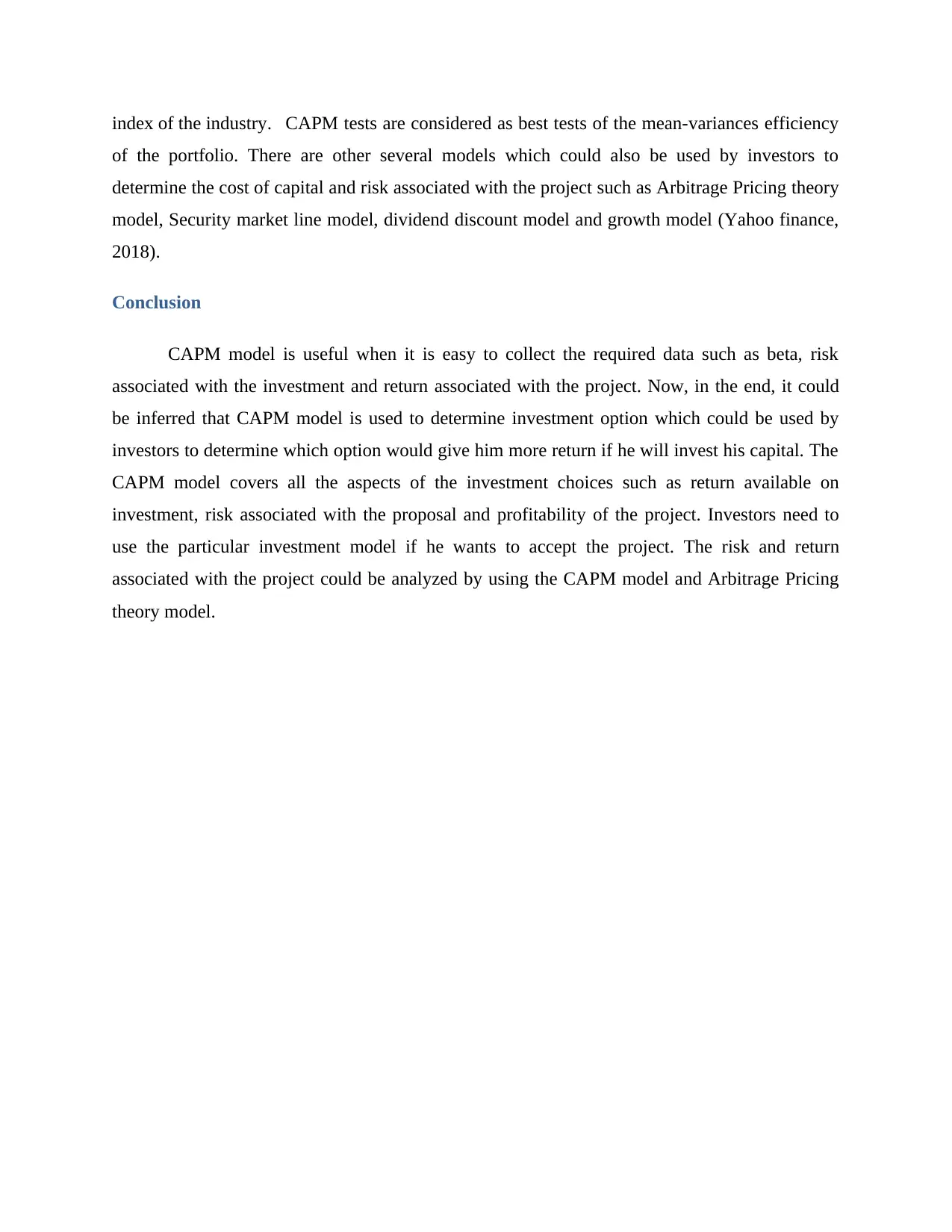
index of the industry. CAPM tests are considered as best tests of the mean-variances efficiency
of the portfolio. There are other several models which could also be used by investors to
determine the cost of capital and risk associated with the project such as Arbitrage Pricing theory
model, Security market line model, dividend discount model and growth model (Yahoo finance,
2018).
Conclusion
CAPM model is useful when it is easy to collect the required data such as beta, risk
associated with the investment and return associated with the project. Now, in the end, it could
be inferred that CAPM model is used to determine investment option which could be used by
investors to determine which option would give him more return if he will invest his capital. The
CAPM model covers all the aspects of the investment choices such as return available on
investment, risk associated with the proposal and profitability of the project. Investors need to
use the particular investment model if he wants to accept the project. The risk and return
associated with the project could be analyzed by using the CAPM model and Arbitrage Pricing
theory model.
of the portfolio. There are other several models which could also be used by investors to
determine the cost of capital and risk associated with the project such as Arbitrage Pricing theory
model, Security market line model, dividend discount model and growth model (Yahoo finance,
2018).
Conclusion
CAPM model is useful when it is easy to collect the required data such as beta, risk
associated with the investment and return associated with the project. Now, in the end, it could
be inferred that CAPM model is used to determine investment option which could be used by
investors to determine which option would give him more return if he will invest his capital. The
CAPM model covers all the aspects of the investment choices such as return available on
investment, risk associated with the proposal and profitability of the project. Investors need to
use the particular investment model if he wants to accept the project. The risk and return
associated with the project could be analyzed by using the CAPM model and Arbitrage Pricing
theory model.
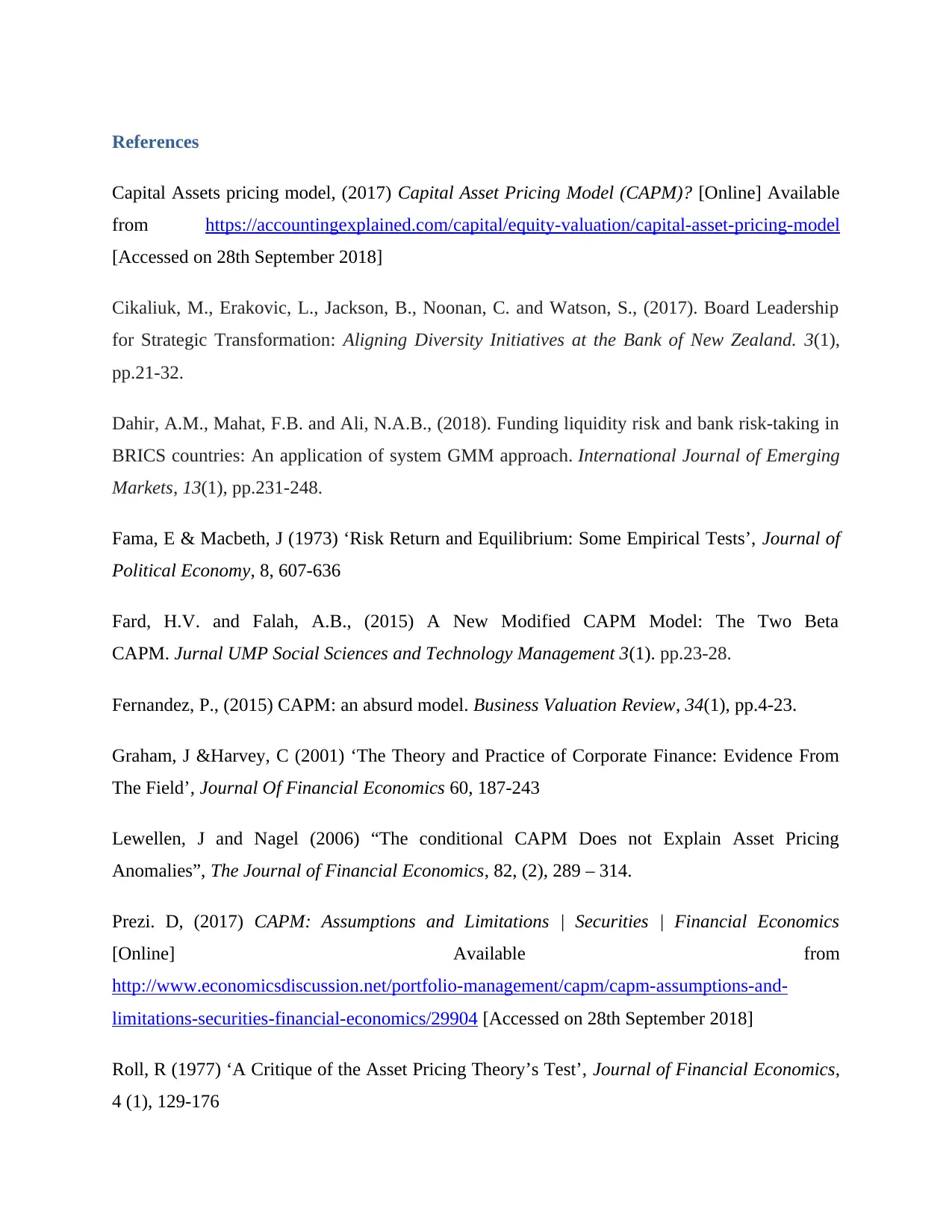
References
Capital Assets pricing model, (2017) Capital Asset Pricing Model (CAPM)? [Online] Available
from https://accountingexplained.com/capital/equity-valuation/capital-asset-pricing-model
[Accessed on 28th September 2018]
Cikaliuk, M., Erakovic, L., Jackson, B., Noonan, C. and Watson, S., (2017). Board Leadership
for Strategic Transformation: Aligning Diversity Initiatives at the Bank of New Zealand. 3(1),
pp.21-32.
Dahir, A.M., Mahat, F.B. and Ali, N.A.B., (2018). Funding liquidity risk and bank risk-taking in
BRICS countries: An application of system GMM approach. International Journal of Emerging
Markets, 13(1), pp.231-248.
Fama, E & Macbeth, J (1973) ‘Risk Return and Equilibrium: Some Empirical Tests’, Journal of
Political Economy, 8, 607-636
Fard, H.V. and Falah, A.B., (2015) A New Modified CAPM Model: The Two Beta
CAPM. Jurnal UMP Social Sciences and Technology Management 3(1). pp.23-28.
Fernandez, P., (2015) CAPM: an absurd model. Business Valuation Review, 34(1), pp.4-23.
Graham, J &Harvey, C (2001) ‘The Theory and Practice of Corporate Finance: Evidence From
The Field’, Journal Of Financial Economics 60, 187-243
Lewellen, J and Nagel (2006) “The conditional CAPM Does not Explain Asset Pricing
Anomalies”, The Journal of Financial Economics, 82, (2), 289 – 314.
Prezi. D, (2017) CAPM: Assumptions and Limitations | Securities | Financial Economics
[Online] Available from
http://www.economicsdiscussion.net/portfolio-management/capm/capm-assumptions-and-
limitations-securities-financial-economics/29904 [Accessed on 28th September 2018]
Roll, R (1977) ‘A Critique of the Asset Pricing Theory’s Test’, Journal of Financial Economics,
4 (1), 129-176
Capital Assets pricing model, (2017) Capital Asset Pricing Model (CAPM)? [Online] Available
from https://accountingexplained.com/capital/equity-valuation/capital-asset-pricing-model
[Accessed on 28th September 2018]
Cikaliuk, M., Erakovic, L., Jackson, B., Noonan, C. and Watson, S., (2017). Board Leadership
for Strategic Transformation: Aligning Diversity Initiatives at the Bank of New Zealand. 3(1),
pp.21-32.
Dahir, A.M., Mahat, F.B. and Ali, N.A.B., (2018). Funding liquidity risk and bank risk-taking in
BRICS countries: An application of system GMM approach. International Journal of Emerging
Markets, 13(1), pp.231-248.
Fama, E & Macbeth, J (1973) ‘Risk Return and Equilibrium: Some Empirical Tests’, Journal of
Political Economy, 8, 607-636
Fard, H.V. and Falah, A.B., (2015) A New Modified CAPM Model: The Two Beta
CAPM. Jurnal UMP Social Sciences and Technology Management 3(1). pp.23-28.
Fernandez, P., (2015) CAPM: an absurd model. Business Valuation Review, 34(1), pp.4-23.
Graham, J &Harvey, C (2001) ‘The Theory and Practice of Corporate Finance: Evidence From
The Field’, Journal Of Financial Economics 60, 187-243
Lewellen, J and Nagel (2006) “The conditional CAPM Does not Explain Asset Pricing
Anomalies”, The Journal of Financial Economics, 82, (2), 289 – 314.
Prezi. D, (2017) CAPM: Assumptions and Limitations | Securities | Financial Economics
[Online] Available from
http://www.economicsdiscussion.net/portfolio-management/capm/capm-assumptions-and-
limitations-securities-financial-economics/29904 [Accessed on 28th September 2018]
Roll, R (1977) ‘A Critique of the Asset Pricing Theory’s Test’, Journal of Financial Economics,
4 (1), 129-176
⊘ This is a preview!⊘
Do you want full access?
Subscribe today to unlock all pages.

Trusted by 1+ million students worldwide

Yahoo finance, (2018), Online] Available from https://in.finance.yahoo.com/[Accessed on 28th
September 2018]
September 2018]
Paraphrase This Document
Need a fresh take? Get an instant paraphrase of this document with our AI Paraphraser


⊘ This is a preview!⊘
Do you want full access?
Subscribe today to unlock all pages.

Trusted by 1+ million students worldwide
1 out of 14
Related Documents
Your All-in-One AI-Powered Toolkit for Academic Success.
+13062052269
info@desklib.com
Available 24*7 on WhatsApp / Email
![[object Object]](/_next/static/media/star-bottom.7253800d.svg)
Unlock your academic potential
Copyright © 2020–2025 A2Z Services. All Rights Reserved. Developed and managed by ZUCOL.





